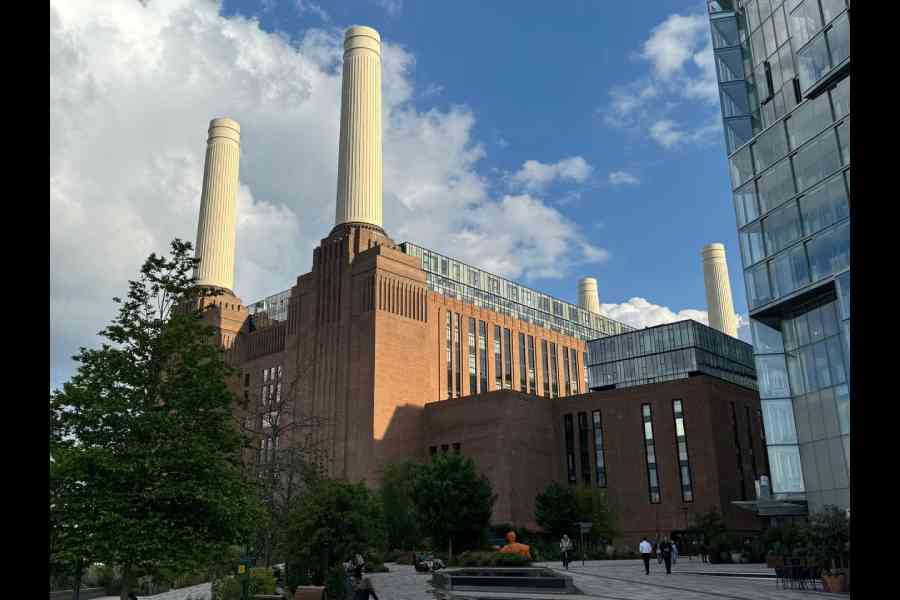Immortalised on the album sleeve of Pink Floyd’s Animals, Battersea Power Station in London is a remarkable example of how iconic buildings that have fallen prey to the march of time can be revived and saved, even if it means losing the sociopolitical argument involving the greed of the ruling elites and the plight of the working class.
Here commercial office space does elbow-bending with luxury living (and some degree of affordable living) but never fails to highlight the thoughtfulness that old buildings need to survive and can be relevant. There’s even an elevator that takes riders to a viewing platform on top to get an inflatable pig’s-eye view of London. It’s this kind of careful planning that can save many beautiful crumbling structures, say, in Calcutta.

The power station has featured in several films and on the cover of Pink Floyd's 1977 album, Animals. There is a reminder of it in front of the building
Smoke to sparkle
The project rolled towards completion only in 2022 after bulldozing a dozen failed proposals, several bankrupt developers and a few billion pounds. For around half a century, the power station burnt enough coal to generate as much as a fifth of London’s electricity, including keeping the lights glowing in Buckingham Palace (codenamed Carnaby Street 2 in the control room) and the House of Parliament. Only in 1983 did the last plumes of smoke leave the four iconic chimneys.
The power station was built in two phases, from 1929 to 1935 and from 1937 to 1955 (interrupted by the World War years) while the decommissioning took place from 1975 to 1983. There were several proposals involving a theme park, a creative space for Cirque de Soleil acrobats and in 2012, Chelsea Football Club proposed a 60,000-seat stadium. Through the many years of proposals, the structure became roofless and the damage was immense.

Architects said they wanted the new power station to reflect the old one. Here's a view of the Apple office which is inside the building
Today, it’s the piece de resistance of a 42-acre site, surrounded by apartment blocks designed by the US architect Frank Gehry and one large structure designed by Foster + Partners. The project is owned by a consortium of Malaysian investors led by SP Setia and Sime Darby Property. They knew what they were up against — a nine-billion pound revamp.
Complicated deals
A large part of the building is today taken up by Apple, which relocated hundreds of its employees from offices around London to make Battersea its UK base. No wonder, the company chose this spot to showcase the creative punch of its new iPad lineup. Years ago, Apple CEO Tim Cook said: “Once a source of energy for much of London, the transformation this building has undergone honours London’s past and celebrates its future. We’re so glad to be a part of it.”
Living with Apple are shops that want to make visitors max out their credit cards — Lego store to Zara to Venchi to Ralph Lauren. Yet, the interiors reflect the original vision of its designer, Giles Gilbert Scott, who also designed London’s red telephone booths. After it was decommissioned, the composer Andrew Lloyd Webber, Warner Bros and even Michael Jackson were interested in investing in the project until they realised this was a white elephant.

During a 10-year project, the four famous white chimneys were dismantled and rebuilt, due to the corrosion of their steel structures
In 1987, the British entrepreneur John Broome bought the site for 1.5 million pounds to make an amusement park out of it, amusing then British prime minister Margaret Thatcher to call it a “wonderful example of private enterprise and local government working hand in hand for the benefit of Britain”. Didn’t we hear something on those lines, time and again, in Yes Minister?! Broome only managed to knock down the power station’s roof and one wall before checking his wallet. Hong Kong investor Victor Hwang stepped in and spent a couple of hundred million pounds over years but it came to naught and by 2006, the action moved to Treasury Holdings, a property investment firm in Dublin. But once again, there was a change in ownership. Yes, the history of this property is that complicated.
Add it to your London itinerary

Old and new architectural styles live side by side at Battersea Power Station
Tourists turning up in London find comfort in visiting St Paul’s Cathedral and the London Bridge but if you make an effort to drive a few miles from London, you will get to experience history of a different kind, besides, of course, an opportunity to shop at some of the finest stores. Instead of glass balustrades, the architects have used steel banisters to add to the camp deco feel of the place. The arrangement of bridges and decks have been cleverly retained. You can still feel the vibe that was captured on the Pink Floyd album cover until you speed away in an Uber Boat service. If only investors, city planners and architects from India can take a look at Battersea Power Station to realise that the old can coexist with modern elements without having to make a financial loss. The superrich are happy shopping at Battersea, which has survived to see a new era.
— Mathures Paul










